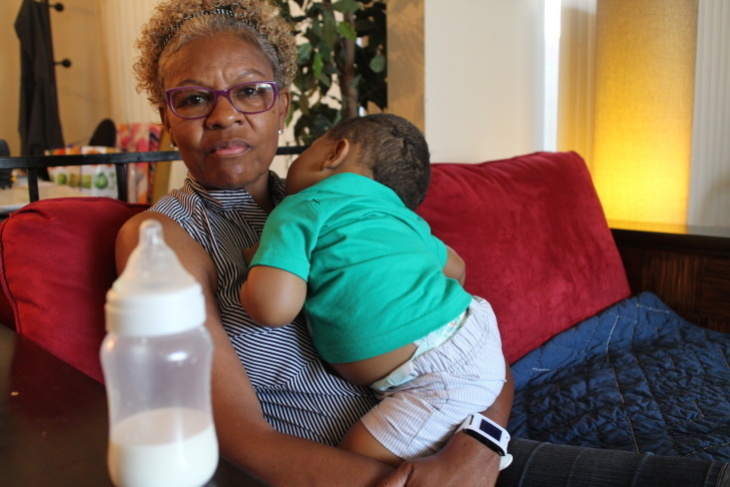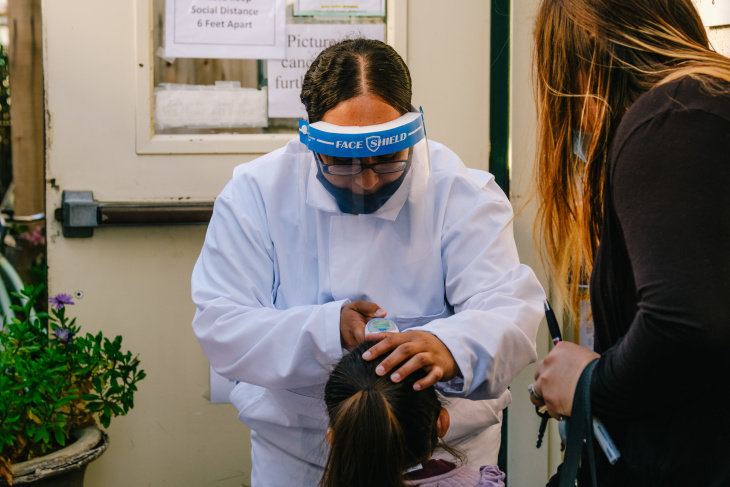
Our news is free on LAist. To make sure you get our coverage: Sign up for our daily newsletters. To support our non-profit public service journalism: Donate Now.
Gov. Gavin Newsom's first budget included $5 million to create a long-term plan for early childhood with strategies to provide universal preschool, increase the availability of child care, train the workforce and fund all of the above.
Almost two years later, with little fanfare, the state this week released the Master Plan for Early Learning Care, a 10-year plan that could reshape programs for young children and their families — if they can secure the funding and the political buy-in.
The 107-page plan outlines almost three dozen proposals, including providing free preschool to all 4-year-olds, expanding paid family leave and changing how child care providers are paid.
"Great roadmap, but now let's show us the money," said Ted Lempert, president of advocacy group Children Now.
The authors estimate it'll cost California an additional $2 billion to $12 billion to make all the proposals a reality — and there aren't many details on where that money will come from.
A spokesman for Newsom's office declined to make anyone available for an interview and responded to LAist's questions via email.
It's also unclear what happens now that this plan exists. Several people who attended a virtual briefing on Thursday asked about the next steps in implementation.
"I think, you know, this is to us, in some ways, a journey to a place of starting," said Jannelle Kubinec, one of the lead authors. "It is about getting this to places that people can now take it and bring the action to it, bring the further voice, bring the next step."
The coronavirus pandemic has exacerbated longstanding problems in California's early learning and care programs. Pparents often can't find affordable child care and when they do, the providers, who are largely women of color, earn poverty-level wages.
The cost of infant care for one child can take up nearly a quarter of California's median family income, according to the Economic Policy Institute. Meanwhile, child care workers in Los Angeles County make an average of $14.65 an hour.
The state agency that licenses child care reported 2,420 home- and center-based programs have permanently closed since the start of the pandemic.
"Having a master plan is great, and we're ready to get to work on it," said Max Arias, chair of Child Care Providers United, the newly formed union representing child care workers. "But we also feel that there has to be an immediate addressing of this crisis or it's gonna be difficult to implement a master plan with no workers."
WHO CREATED THIS PLAN?
Mainly, a San Francisco-based non-profit educational research organization called WestEd.
Its staff, including Kubinec, worked with several other groups including Stanford University, think tank RAND, Child Trends and American Institutes for Research.
The Early Childhood Policy Council, a group of child care providers, parents, advocates and other experts, advised on the plan's creation but didn't have the final say over what went in it. The full council met six times this year via Zoom. A larger parent engagement effort was scrapped during the pandemic but the plan noted 3,000 people attended the policy council's virtual meetings.
The authors also incorporated ideas from several other sets of recommendations from recent years including the Assembly Blue Ribbon Commission on Early Childhood Education's report.
"There's not any part of this that's simply derived from wishful thinking, this is derived from need," said State Senator-elect Monique Limón, who introduced the bill that paved the way for this year's family child care provider unionization.
The legislature authorized up to $5 million for the plan, and a spokesman for Governor Newsom said in an email, invoices are still being processed and the expectation is that the plan would come in under budget.
UNPACKING THE PLAN
The master plan connects all its initiatives to four main goals:
- Improving access to early care and education programs
- Untangling the bureaucracy that manages these programs
- Updating standards and training the workforce
- Changing how the state pays providers who care for kids from low-income families.
"We have to see it as the beginning of the conversation, and work together to really think how can we make this happen now and see it as an opportunity to build a system that maybe should work for all kids and families," said Patricia Lozano, the executive director of the non-profit Early Edge California and a contributor to the plan.
We're going to break down a few parts of the plan below.
Universal Preschool
Only families who are homeless, make 70% or below the state median income (for example, a family of 4 with a household income of $70,000 or lower) or children who are high-risk for abuse can currently attend California's state preschool program. The plan envisions a preschool program that every 4-year-old could attend free of charge.
The first priority would be expanding programs at elementary schools in high-poverty neighborhoods. Then, over time, state-funded preschool would be extended to all 3-year-olds from low-income families and to children with disabilities.
Making It Easier For Families To Get Services
Right now, families applying for assistance programs like MediCal, CalWORKS and CalFresh have to apply for child care separately. It can take a lot of time and paperwork before parents and caregivers find out which, if any, of the state's myriad subsidized child care programs they're eligible for.
"I think the streamlining eligibility for programs is an example of 'how do we make this support easier for parents to navigate complex resources' to support their child's development," said First 5 LA senior vice president Christina Altmayer, one of the plan's contributors.
The plan proposes that families eligible for one program, say MediCal, are able to enroll in subsidized child care more quickly.
Changing How Providers Are Paid

Providing high-quality child care costs more than any one source pays and providers often make up the difference by taking money out of their own pockets.
"The state's current reimbursement rate structure is overly complex and inequitable," the report reads.
Not only that, but the information California uses to pay providers who care for children from low-income families is based on data collected in 2016, even though there's more recent information available. For example, the maximum amount a Los Angeles County family child care provider can earn from the state by caring for an infant is $56 per day.
"Historically... the actual workers have had to acclimate to those organizations based on their perception of what is needed in the field," said Bellflower family child care provider Tonia McMillian. "What I like about this master plan, is that now they need to figure out how to acclimate themselves to the reality of what's happening out in the field."
The plan proposes establishing a base rate and adding additional money depending on where a provider is located, the quality of care, certain characteristics of the child like disabilities, risk for abuse, age and whether they're dual language learners.
Improving Paid Family Leave
California has offered paid family leave since 2004, when it became the first state to do so. Parents can get up to eight weeks a year to care for a new child while receiving 60% to 70% of their salary. A law that takes effect next year extends job protection for up to 12 weeks of leave for anyone who works at a company with more than five employees.
"Despite this progress, parents experiencing poverty and parents of color who need the leave the most continue to have the most trouble accessing it (paid family leave)," the plan notes.
The recommendation is to increase wage replacement rates to 90% for low-income families with newborns, increase the length of paid family leave and create new support for businesses with fewer than 10 employees while their workers are out on leave.
Equity
The word equity appears almost 50 times in the plan in relation to families, kids and the early childhood workforce. Specifically, the plan proposes that early learning and care providers who receive public funding ban suspensions and expulsions — Black preschoolers are far more likely than their white peers to be suspended — reserve 10% of their enrollment for children with disabilities and that providers receive more support and training to advance their careers.
California's child care workforce is largely women of color and in L.A. County they make an average of $14.65 an hour. Researchers at UC Berkeley found nationally African American and Latino early educators often fill the field's lowest-paying jobs.
Identifying Bilingual Learners
More than half of the state's young children — 60% — speak a language at home other than English, according to a UCLA study.
The plan calls for creating a new system to collect information about dual language learners in publicly funded early learning programs, training providers on language development and updating curriculum.
WHO'S PAYING FOR THIS?
Here's where there's the most blank space on this roadmap to a better early childhood system.
The plan's authors estimate the state and families already pay about $12 billion on early learning and care every year.
Actually doing everything the plan proposes — increasing paid family leave, universal preschool, reforming provider pay, etc . — could cost up to twice that amount.
The plan estimates the additional costs are between $2 billion and $12 billion, "supported through public investments, business contributions, philanthropy, and family fees."
Governor Newsom's communications director, Jesse Melgar, wrote in an email that the range is so broad because the initiatives in the plan could be "achieved through different policy choices and are likely to be phased in over time."

"The lower end of the estimates assumes that some increases are provided but there is not significant expansion to child care and change to program and workforce standards," Melgar wrote. "The higher end of the estimate is what it would take to fully meet the 2030 objectives described in the plan."
Some lawmakers are already thinking about how the master plan might translate into legislation in the upcoming session, though the full economic impact of the pandemic is still unknown. The most recent state budget had a $54 billion deficit.
"This is probably not something that politicians say very often, but these programs are expensive," said Assembly Speaker Anthony Rendon. "They save money in the long term, but, the upfront costs are expensive."
Rendon formed a commission that issued its own set of recommendations for early care and education last year.
"The budget situation this year is going to be different than it has been in previous years, but I think we need to make this investment," Rendon said.
I HAVE THOUGHTS AND QUESTIONS ABOUT THE MASTER PLAN
There are a few ways to get more involved:
- Fill out an online survey about the plan.
- Find out which assemblymember and senator represent you in the California legislature and tell them what you think is important.
- Attend the next Early Childhood Policy Council meeting, Thursday, Dec. 10 at 2:30 p.m. by registering here.
- Contact this reporter by using the box at the bottom of the page.
EVEN MORE DOCUMENTS WE USED TO WRITE THIS STORY
"plan" - Google News
December 05, 2020 at 02:31AM
https://ift.tt/2JBb9It
A 10-Year Plan For Early Childhood In California With Uncertain Next Steps - LAist
"plan" - Google News
https://ift.tt/2un5VYV
Shoes Man Tutorial
Pos News Update
Meme Update
Korean Entertainment News
Japan News Update
Bagikan Berita Ini














0 Response to "A 10-Year Plan For Early Childhood In California With Uncertain Next Steps - LAist"
Post a Comment